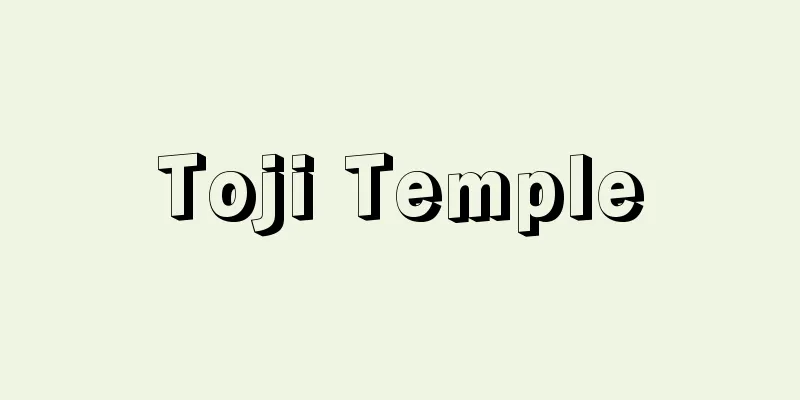Toji Temple

|
This temple is located in Kujo-cho, Minami-ku, Kyoto City. It is the head temple of the Toji Shingon sect. Its correct name is Konkomyo Shitennokyo Ogokokuji Himitsu Denpoin (or Kyoogokokuji for short). The principal image is Yakushi Nyorai. With the transfer of the capital to Heian in 794 (Enryaku 13), two temples were built on either side of Rajomon Gate to protect the royal palace, and were called Toji (also called the left temple or the left large temple) and Saiji (the right temple or the right large temple). Construction of the two temples began around 796, when Dainagon Fujiwara Isen-do was appointed as the chief temple builder. However, it was not until 823 (Kōnin 14) when Emperor Saga bestowed Toji Temple to Kobo Daishi Kukai, and the temple became the main training center for Esoteric Shingon Buddhism, that Toji Temple began to attract a wide range of believers, from the imperial family and aristocrats to common people. After returning from China in 806 (Daido 1), Kukai worked to spread the teachings of Esoteric Shingon Buddhism, and in 819 built a temple at Mount Koya and founded Kongobuji Temple. Around this time, he came into conflict with Saicho, who was preaching exoteric Buddhism at Enryakuji Temple on Mount Hiei. Emperor Saga mediated the matter by officially recognizing the teachings of both men and bestowing Toji Temple on Kukai. Kukai requested that the resident monks at Toji Temple not include monks other than Shingon monks, and this was approved. Up until that point, all government-run temples had aimed to encourage the study of various sects, so the monopoly of a government-run temple by one sect was a groundbreaking development. From then on, Japanese Buddhism underwent a major transformation from government-run temple Buddhism to sectarian Buddhism. Kukai built a five-story pagoda and lecture hall at Toji Temple and improved its appearance, but after his death in 835 (Jowa 2), the center of Shingon Buddhism's faith and teachings shifted to Mount Koya, and Toji Temple began to decline somewhat. Nevertheless, its status as a government temple was superior to other temples, as the national memorial service for the Imperial Family was frequently held there. Towards the end of the Heian period, the temple buildings fell into disrepair and control over the temple estates began to loosen. The fundraising monk Mongaku (secular name Endo Morito) then aimed to rebuild Toji Temple, using the momentum he had gained from rebuilding Jingoji Temple on Mount Takao in Kyoto, which had a connection to Kukai. In response to this advice, Emperor Goshirakawa designated Harima Province (Hyogo Prefecture) as a land for repairs in 1189 (Bun'ji 5), and the Shogun Minamoto no Yoritomo, who was in power shortly after the start of the Kamakura period, also gave great support to Munkaku's fundraising activities in various provinces. The reconstruction of temples and buildings was almost complete by around 1197 (Kenkyu 8), but Munkaku lost his position with the death of Yoritomo in 1199 (Shoji 1), and the reconstruction work was halted. From the mid-13th century onwards, the efforts of Gyohen and others led to a favorable turnaround in the control of the vast temple estates across the country, and later, with the emergence of figures such as Daikanjin Gangyo Shonin Kensei, who restored the five-story pagoda in 1285 (Kōan 8), Toji Temple also enjoyed great economic stability in the Middle Ages. During the Nanboku-chō and Muromachi periods, the temple was caught up in repeated wars and temple buildings were burned down, but thanks to the efforts of nobles, samurai and the general public, they were rebuilt each time. However, during the Kyoto Tokusei Ikki in 1486 (Bunmei 18), peasant rebels barricaded themselves in the temple and set it on fire, reducing the main hall and most other buildings to ashes. Toyotomi Hideyoshi granted the temple land of over 2,000 koku in Yamashiro Province in 1591 (Tensho 19). The Tokugawa Shogunate that followed also recognized it as Shuinji land and restored the five-story pagoda and other buildings. In the Meiji period, many sub-temples were abolished due to the separation of Shinto and Buddhism and the abandonment of Buddhism. In the early Meiji period, it became the head temple of the Shingon sect, but later separated from various sects, and in 1974 (Showa 49), Toji Shingon sect was formed and it became its head temple. The Goshichinichi no Mishiho (After Seven Days Ascetic Ceremony), which began during the time of Kukai, is performed every year from January 8th to 14th by all Shingon sects. Toji is a government-run temple, an esoteric Buddhism training center, and a sacred site for the Great Master. The Saiin temple, where Kukai lived, was originally dedicated to Acala, but when a statue of Kukai was placed in the front hall during the Kamakura period, it came to be called the Daishido and Mieido. The current building was rebuilt in 1380 (Tenju 6, Koryaku 2), and it was around that time that many people who admired Kukai's virtues began to make pilgrimages to the Daishido. Even today, the Mieku ceremony held at the Daishido on the 21st of each month, the anniversary of his death (the main Mieku is on April 21st), is called "Kobo-san" and is crowded with many pilgrims. [Kanaoka Hidetomo] Cultural AssetsNone of the buildings are from the original construction, but the layout of the temple buildings, with the Great South Gate, Main Hall, Lecture Hall, and Dining Hall lined up in a straight line, is a tradition inherited from the great temples of Nara. The five-story pagoda (a national treasure) is about 55 meters tall and is the tallest and largest pagoda in Japan. The current pagoda was rebuilt in 1644 (Kan'ei 21) with a donation from Tokugawa Iemitsu, and the wooden walls inside the first floor feature statues of the Eight Patriarchs of Shingon Buddhism, while the ceiling is painted in brilliant colors with floral patterns. Other buildings designated as national treasures include the Main Hall (Momoyama period), Daishi Hall (Muromachi period), and Rengemon Gate (Kamakura period), while the Lecture Hall (Muromachi period) and Kanjoin (Edo period) are designated as Important Cultural Properties of Japan. The temple's treasures include many relics that Kukai brought back from the Tang Dynasty, as well as a vast number of sculptures, paintings, crafts, and documents from the Heian period onwards. There are also many national treasures and important national cultural properties, making it known as a treasure trove of Buddhist art. In the lecture hall, there are a total of 21 statues enshrined: the Five Buddhas in the center, the Five Great Bodhisattvas to the east, the Five Great Wisdom Kings to the west, Bonten and Taishakuten to the east and west, and the Four Heavenly Kings at the four corners (all of which are national treasures). This arrangement is said to be an attempt by Kukai to embody the ideals of esoteric Buddhism, and the statues themselves are highly valued as the oldest masterpieces of esoteric Buddhist sculpture. The Daishi Hall houses masterpieces such as statues of Acala, the Sogata Hachiman, statues of a god and a god (all national treasures), while the dining hall houses the statue of Tobatsuba Bishamonten (national treasure), which was brought from China. Paintings include the Five Great Deities, the Seven Shingon Patriarchs, the Mandala of Both Realms, and the Twelve Devas folding screen; art works include the Kaifu makie kesa box, the Kenda kokushi kesa, the rosewood-lacquered and mother-of-pearl-decorated Shari-ren, as well as esoteric Buddhist ritual implements (a diamond plate, a five-pronged bell, and a five-pronged vajra); and calligraphy works include the scale tablet written by Kobo Daishi, known as the "Fushinjo," and the "Catalogue of the Arrivals of Kobo Daishi" written by Saicho. In addition, the Toji Temple history "Tobo-ki" (National Treasure) and the "Toji Hyakugo Monjo", a collection of over 20,000 documents once owned by the temple, are considered essential historical materials for the study of ancient and medieval history. The "Toji Hyakugo Monjo" was registered as a Memory of the World (currently the Memory of the World) by the United Nations Educational, Scientific and Cultural Organization (UNESCO) in 2015. The sub-temple Kanchi-in was founded by Emperor Go-Uda, and its guest hall, built during the Momoyama period, is a national treasure. To-ji Temple was registered as a World Heritage Site in 1994 (Heisei 6). (World Heritage Sites. Kyoto's cultural assets include 17 shrines, temples, and castles, including Kiyomizu-dera Temple.) [Kanaoka Hidetomo] Toji Temple territoryThis refers to the branch temples, manors, scattered territories, construction fee provinces, and scattered places that paid annual taxes, official duties, and miscellaneous services to Toji Temple. Its branch temples include Kongobu-ji Temple, Gufuku-ji Temple, Chinno-ji Temple, Zentsu-ji Temple, Mandala-ji Temple, and Houn-ji Temple, and they provided offerings and food for Toji Temple's religious ceremonies. The manorial estates of Toji Temple in the early days included Ise Okuni Manor, Kawai Manor, Settsu Tarumi Manor, Tamba Oyama Manor, and the rice fields around Toji Temple. Later, Owari Onari Manor was added, and these manors became Choja Watariryo at the end of the Heian period, and the manorial authority was later transferred to the executive and then the monk. The increase in the temple land in the Middle Ages can be divided into three periods. The first was the donation of the lands of Senyomon'in and Omuro of Ninnaji Temple through the efforts of Gyohen, Bodaiin of Ninnaji Temple. The manor of Yamato Hiranodono, the manor of Iyo Yugeshima, the manor of Aki Shinchokushiden, the manor of Bizen Tottori (later replaced by the manor of Tanba Noguchi), the manor of Wakasa Tara, etc. were allotted as tribute manors, and this led to the establishment of the Shue organization, which became the basis of the 18 groups of tribute manors. The second was the establishment of tribute manors and scholars by the nobles and samurai from the late Kamakura period to the Northern and Southern Courts period, and the donation of tribute manors to them. Emperor Goda donated the Yamashiro Haishi Manor, Kamikatsura Manor, Hachijoin-cho, Harima Yano Manor, and Hitachi Shinda Manor, along with the new recruits of the 21st group of offering monks and scholars, and Emperor Godaigo appointed the Kangakkai monks as administrative officers of Hosogon-in, the Kodo and Kanjoin goma offering monks as administrative officers of Saishoko-in, and the Fudodo constant goma offering monk as land steward of the manors of Oyama, Tara, and Bitchu Niimi. The main manors associated with the two offices were, for Takara Shogon-in, Omi Mimura Manor, Hayami Manor, Tanba Kadono Manor, Totomi Hatsukura Manor, and Awa Ono Manor, and for Saishoko-in, Bitchu Niimi Manor, Suo Miwa Manor, Hizen Matsuura Manor, Higo Kamikura Manor, Totomi Harada Manor, Murakushi Manor, and Kyoto Yanagihara Manor. In the Nanboku-cho period, Ashikaga Takauji donated the land stewardship of Yamashiro Kuzekamishimo Manor to the guardian deity Hachimangu Shrine, Kawachi Shingai Manor (later changed to Bingo Innoshima Manor and Settsu Mimasaka Manor) to the Daisho Kongo-gu and Senju-gu monks, and Ashikaga Yoshiakira donated the land stewardship of Yamashiro Uematsu Manor. The third donation was the donation of Kyoto and scattered Yamashiro territories to Miedo Hall, which was based on the faith in Daishi, which began in the late Kamakura period and flourished in the Muromachi period. Thus, the manors and territories of medieval Toji Temple, which were formed mainly around the revenue offices of the monks and scholars, were controlled by organizations such as the 18th, 21st, and Gakushu organizations organized by the monks and scholars. In addition, there were also the revenue offices of Kosho, Tozai Kujo Nyogoden, Mikawa Yamanakago, and other areas managed by the Zoei-kata, as well as a few Choja and Executing Kanryo territories. Some of these manors became unregistered shortly after being donated, but the manors in the Kinai region, such as Kuze-sho, continued to be managed until the Sengoku period. Since the early Kamakura period, the provinces of Harima, Higo, Tango, Sado, Shimotsuke, and Hitachi have been donated as construction fees, but it was Aki Province that became the permanent fee province. In addition, customs fees from Yodo-tsu and its successor, Funaki Barrier on Lake Omi, were also donated as construction fees. Regarding the Sansho, in 1318 (Bunpo 2), Emperor Go-Uda donated 15 Sansho monks as a cleaning fee to the monks and scholars, and they continued to perform miscellaneous tasks such as cleaning and guarding the temple grounds. [Toshiko Ito] "The Toji Temple Cultural Properties Preservation Society, ed. "The Master's View of Toji Temple" (1965, Bijutsu Shuppansha)" ▽ "The Hidden Treasures of Toji Temple, by Sawa Takaken (1969, Kodansha) " ▽ "Toji Temple and Mount Koya, ed. by Ota Hirotaro et al. ("Treasures of Japanese Art 8", 1981, Shogakukan)" ▽ "Kyoogokokuji Documents, 10 volumes, illustrations, ed. by Akamatsu Toshihide (1960-71, Heirakuji Shoten)" [References] | |Source: Shogakukan Encyclopedia Nipponica About Encyclopedia Nipponica Information | Legend |
|
京都市南区九条町にある寺。東寺真言(しんごん)宗の総本山。正しくは金光明(こんこうみょう)四天王教王護国寺秘密伝法院(略して教王護国寺)という。本尊は薬師如来(にょらい)。794年(延暦13)の平安遷都に伴い、王城鎮護のために羅城(らじょう)門の左右に2か寺が建立され、それぞれ東寺(左寺、左大寺とも)、西寺(さいじ)(右寺、右大寺)と称した。東西両寺の造営が開始されたのは796年ごろで、大納言(だいなごん)藤原伊勢人(いせんど)が造寺長官に任命された。しかし、そのうちの東寺が皇族・貴族から庶民に至る広い信仰を集めるようになったのは、823年(弘仁14)に嵯峨(さが)天皇が東寺を弘法大師(こうぼうだいし)空海に勅賜し、当寺が真言密教の根本道場となってからである。 空海は、806年(大同1)唐より帰国後、真言密教の布教に努め、819年から高野山(こうやさん)に伽藍(がらん)を建立、金剛峯寺(こんごうぶじ)を開いた。このころより比叡山(ひえいざん)の延暦寺(えんりゃくじ)にあって顕教を説いていた最澄(さいちょう)と対立。嵯峨天皇はその調停として両者の教学を公認するとともに、空海に東寺を与えた。空海は、東寺の住僧に真言宗僧以外の僧を交えぬよう要請して認められた。それまでのあらゆる官寺は諸宗兼学を旨としており、一宗による官寺の独占は画期的なことであった。以後日本の仏教は官寺仏教から宗派仏教へと大きく変貌(へんぼう)していく。空海は東寺に五重塔や講堂を建立して寺観を整えたが、835年(承和2)空海の没後、真言宗の信仰と教学の中心は高野山に移り、東寺はやや衰えをみせる。それでも天皇家の国忌がたびたび修されるなど、官寺としての地位は他寺にぬきんでていた。平安時代末ごろになると、寺堂の荒廃が進み寺領荘園(しょうえん)の支配も緩みがちとなった。そこで勧進僧(かんじんそう)文覚(もんがく)(俗名遠藤盛遠(もりとお))は、空海由縁の京都高雄山(たかおさん)神護寺(じんごじ)の再興を果たした勢いで東寺再興を志した。その進言に応じて、後白河(ごしらかわ)院は1189年(文治5)に播磨(はりま)国(兵庫県)を修造料国にあて、また鎌倉開幕まもない将軍源頼朝(よりとも)も、文覚の諸国での勧進活動を大いに支援した。1197年(建久8)ごろまでに寺堂の再興事業はほぼ完成したが、1199年(正治1)の頼朝の死により文覚は失脚し、復興事業は中断された。 13世紀中ごろ以降、行遍(ぎょうへん)らの活躍で、全国にあった広大な寺領荘園の支配が好転し、その後1285年(弘安8)に五重塔の再興を果たした大勧進願行上人(がんぎょうしょうにん)憲静なども登場して、中世においては東寺は経済的にも大いに安定した。南北朝・室町時代は、たび重なる戦乱に巻き込まれて寺堂を焼亡することもあったが、公家(くげ)・武家および民衆の尽力でそのつど再興された。しかし、1486年(文明18)の京都徳政一揆(いっき)のとき、土一揆勢が当寺に立てこもって放火したため、金堂以下ほとんどの建物が灰燼(かいじん)に帰した。豊臣(とよとみ)秀吉は1591年(天正19)に山城(やましろ)国内の2000石余を寺領として安堵(あんど)。続く徳川幕府もそれを朱印寺領として認めるとともに、五重塔をはじめ諸堂を再興した。明治期には、神仏分離、廃仏棄釈によって多くの塔頭(たっちゅう)が廃された。明治初年に真言宗の総本山となったが、のち諸派と分離し、1974年(昭和49)東寺真言宗が結成され、その総本山となる。空海のときに始められた後七日御修法(ごしちにちのみしほ)は毎年1月8~14日に全真言宗合同のもとに厳修されている。東寺は官立護国寺、密教道場に加えて大師霊場でもある。空海の住房であった西院(さいいん)にはもと不動明王が祀(まつ)られていたが、鎌倉時代に前堂に空海の像が安置されると、大師堂、御影堂(みえいどう)とよばれるに至った。現在の建物は1380年(天授6・康暦2)の再建であるが、そのころから大師堂に空海の徳を慕う多くの人々が参詣(さんけい)するようになった。いまでも毎月21日の命日に大師堂で行われる御影供(みえく)(正御影供は4月21日)は「弘法さん」とよばれて大ぜいの参詣者でにぎわう。 [金岡秀友] 文化財建造物には創建当初のものはないが、南大門から金堂、講堂、食堂(じきどう)と一直線に並ぶ伽藍(がらん)配置は奈良の諸大寺の伝統を受け継いでいる。五重塔(国宝)は総高約55メートル、日本の塔のうち最高最大のものである。現在の塔は1644年(寛永21)徳川家光(いえみつ)の寄進により再建されたもので、初層内部の板壁には真言八祖像、天井には花文が極彩色で描かれている。そのほか建造物では金堂(桃山時代)、大師堂(室町時代)、蓮華(れんげ)門(鎌倉時代)が国宝に、講堂(室町時代)、灌頂(かんじょう)院(江戸時代)などが国重要文化財に指定されている。寺宝は、空海が唐から持ち帰った多くの遺品をはじめ、平安時代以来の彫刻、絵画、工芸、文書などおびただしい数に上り、国宝、国重要文化財も非常に多く、仏教美術の宝庫といわれる。講堂内には中央に五如来(にょらい)像、東方に五大菩薩(ぼさつ)像、西方に五大明王(みょうおう)像、東西に梵天(ぼんてん)・帝釈天(たいしゃくてん)像、四隅に四天王像(以上すべて国宝)の計21尊を安置。その配置は空海が密教の理想を具現しようとしたものとされ、また諸像は密教彫刻最古の傑作として重んじられている。大師堂には不動明王像、僧形八幡(はちまん)神像、女神像、神像(以上国宝)など、食堂には唐から請来(しょうらい)された兜跋毘沙門天(とばつびしゃもんてん)像(国宝)などの名品を安置している。絵画では五大尊像、真言七祖像、両界曼荼羅(まんだら)図、十二天屏風(びょうぶ)など、工芸品には海賦蒔絵袈裟(かいふまきえけさ)箱、犍陀穀糸(けんだこくし)袈裟、紫檀(したん)塗螺鈿(らでん)装舎利輦(しゃりれん)のほか、密教法具(金剛盤(こんごうばん)、五鈷鈴(ごこれい)、五鈷杵(ごこしょ))など、書では「風信帖(じょう)」の名で知られる弘法大師筆尺牘(せきとく)、最澄筆「弘法大師請来目録」などが国宝に指定されている。また、東寺の寺史『東宝記(とうぼうき)』(国宝)や、かつて東寺が所蔵していた2万点余の文書「東寺百合文書(ひゃくごうもんじょ)」は古代・中世史研究に不可欠の史料として重視されている。「東寺百合文書」は2015年(平成27)、国連教育科学文化機関(ユネスコ)の世界記憶遺産(現、世界の記憶)に登録された。 なお、塔頭の観智(かんち)院は後宇多(ごうだ)天皇により創立されたもので、桃山建築の客殿は国宝である。東寺は、1994年(平成6)世界遺産の文化遺産として登録された(世界文化遺産。京都の文化財は清水寺など17社寺・城が一括登録されている)。 [金岡秀友] 東寺領東寺に対して年貢、公事(くじ)、雑役(ぞうやく)などを負担する末寺、荘園、散在所領、造営料国、散所(さんじょ)などをさす。 末寺には、金剛峯寺、弘福寺(ぐふくじ)、珍皇寺(ちんのうじ)、善通寺(ぜんつうじ)、曼荼羅寺(まんだらじ)、法雲寺(ほううんじ)などがあり、東寺の法会(ほうえ)の供物や饗料(きょうりょう)を勤仕していた。 東寺草創期の荘園所領は、伊勢大国(いせおおくに)荘・川合(かわい)荘、摂津垂水(せっつたるみ)荘、丹波大山(たんばおおやま)荘、東寺寺辺水田などで、のち尾張大成(おわりおおなり)荘を加えて、これらの荘園は平安時代末期には長者渡領(ちょうじゃわたりりょう)となり、その後、荘務権は執行(しぎょう)そして供僧(ぐそう)へと移っている。ついで中世における寺領増加の動きは次の三つに分けられる。第一は、仁和寺菩提院(にんなじぼだいいん)行遍(ぎょうへん)の働きかけによる宣陽門院(せんようもんいん)、仁和寺御室(おむろ)の所領寄進である。大和平野殿(やまとひらのどの)荘、伊与弓削島(いよゆげしま)荘、安芸新勅旨田(あきしんちょくしでん)、備前(びぜん)鳥取荘(のち丹波野口荘にかわる)、若狭太良(わかさたら)荘などが供僧料荘にあてられ、それによって十八口(じゅうはっく)供僧の基礎となる衆会(しゅうえ)組織が発足した。第二は、鎌倉後期から南北朝期にかけての公家・武家による供僧・学衆の新たな設置とその料荘の寄進である。後宇多(ごうだ)院は廿一口(にじゅういっく)供僧・学衆の新補とあわせて、山城拝師(やましろはいし)荘・上桂(かみかつら)荘・八条院町(はちじょういんのちょう)、播磨矢野(はりまやの)荘、常陸信太(ひたちしだ)荘を寄進、後醍醐(ごだいご)天皇は勧学会衆に宝荘厳院執務職(ほうそうごんいんしつむしき)を、講堂・灌頂院(かんじょういん)護摩供僧に最勝光院(さいしょうこういん)執務職を、不動堂不断護摩供僧に大山・太良・備中新見(びっちゅうにいみ)各荘地頭(じとう)職をあてた。両執務職に伴うおもな荘園は、宝荘厳院が近江三村(おうみみむら)荘・速水(はやみ)荘、丹波葛野(かどの)荘、遠江初倉(とおとうみはつくら)荘、阿波(あわ)大野荘、最勝光院が備中新見荘、周防美和(みわ)荘、肥前松浦(ひぜんまつら)荘、肥後神倉(ひごかみくら)荘、遠江原田(はらだ)荘・村櫛(むらくし)荘、京都柳原(やなぎはら)などである。南北朝期に入って足利尊氏(あしかがたかうじ)が鎮守八幡宮(はちまんぐう)に山城久世上下(くぜかみしも)荘地頭職を、大勝金剛供・千手供供僧に河内新開(かわちしんがい)荘(のち備後因島(びんごいんのしま)荘、摂津美作(みまさか)荘にかわる)を寄せ、足利義詮(よしあきら)が山城植松(うえまつ)荘地頭職を寄進している。第三は、鎌倉後期に始まり室町期に盛行した、大師信仰に基づく御影堂(みえいどう)への京都および山城散在所領の寄進である。 このように主として供僧・学衆料所を中心に形成されてきた中世東寺の荘園所領は、供僧・学衆が組織する十八口方、廿一口方、学衆方、最勝光院方、宝荘厳院方、鎮守八幡宮方、不動堂方、植松荘方などの機構によって支配されていた。そのほかにも、造営方の管領する巷所(こうしょ)・東西九条女御田(とうざいくじょうにょごでん)、三河山中郷などの造営料所や若干の長者・執行管領所領があった。これら諸荘には寄進後まもなく不知行(ふちぎょう)になったものもあるが、久世荘など畿内(きない)膝下(しっか)荘園所領は戦国期に至るまで経営が続けられた。 造営料国としては、鎌倉時代初期以来、播磨、肥後、丹後、佐渡、下野(しもつけ)、常陸(ひたち)などが寄せられたが、永代料国となったのは安芸国である。また、淀津(よどのつ)やそれにかわる近江湖上船木(ふなき)関の関銭も造営料として寄進されている。 散所については、1318年(文保2)後宇多院が、供僧・学衆に掃除料として散所法師(さんじょほうし)15人を寄進しており、以後も寺内の掃除・警衛などの雑役を勤めた。 [伊藤敏子] 『東寺文化財保存会編『大師のみてら東寺』(1965・美術出版社)』▽『佐和隆研著『秘宝東寺』(1969・講談社)』▽『太田博太郎他編「東寺と高野山」(『名宝日本の美術8』1981・小学館)』▽『赤松俊秀編『教王護国寺文書』全10巻・絵図(1960~71・平楽寺書店)』 [参照項目] | |出典 小学館 日本大百科全書(ニッポニカ)日本大百科全書(ニッポニカ)について 情報 | 凡例 |
Recommend
Temporal bone
…It is a rectangular dish-shaped bone connected b...
《Idene》
...The latter is a monumental work that heralds t...
Ise Navy
Maritime transport has been active in the Ise regi...
President Gambling - Sochoto Baku
This film, officially titled Gambling Boss Tobaku ...
Laws of Thermodynamics
The principles of thermodynamics, or fundamental ...
Law seal - Houin
〘Noun〙 Buddhist term. ① (translation of dharma-udd...
Improvisatoren (English: Improvisator)
A full-length novel by Danish author Hans Christi...
Fante Confederation - Fante Confederation
The Fante National Union was formed in the late 19...
Baluster (English spelling)
A vertical beam that supports the top rail of a ha...
Interfacial notation
A method of expressing the plan, scale, and style ...
One-mon coin - Ichimonsen
〘Noun〙① A small denomination coin worth one mon. I...
Ibn Yunus
?‐1009 Arab astronomer. He conducted observations ...
Lynx (Lynx)
Its abbreviation is Lyn. It is a small constellati...
Cow's foot grass - Cow's foot grass
...Several species are cultivated for flower beds...
Hoysala Dynasty - Hoysala
A dynasty in South India. With its capital in Dva...



![Airbus Industry [company] - Airbus Industrie](/upload/images/67cf95e143a19.webp)





